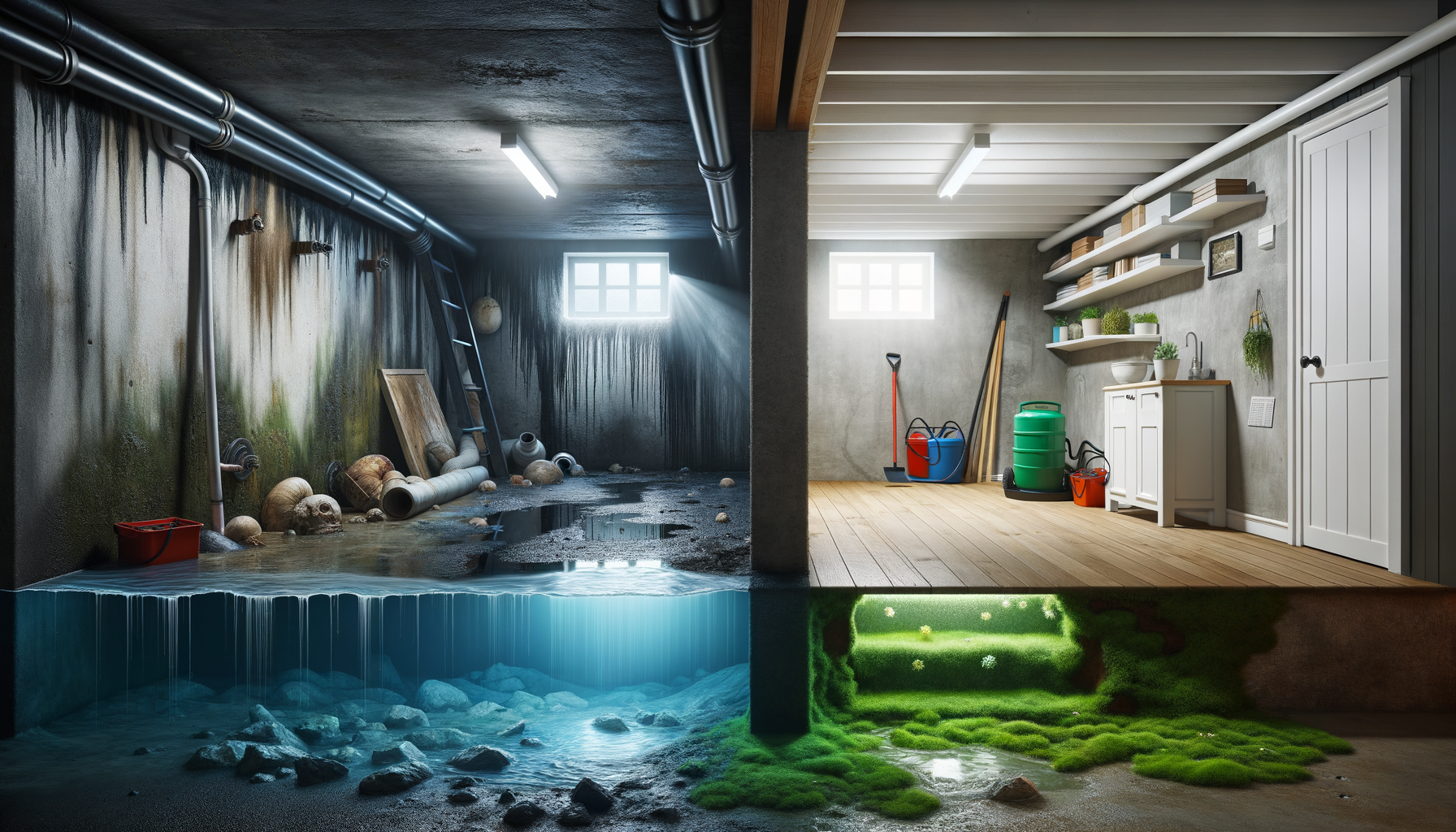Recognizing Water Damage
Early Signs of Water Damage
- Damp spots on walls or floor: Look for areas in your basement that are always wet or have water stains.
- Mold and mildew growth: Mold smells musty and can make you sick. If you see or smell mold, it means there’s a moisture problem.
- Musty odors: Even if you don’t see mold, a musty smell can mean hidden water damage.
Common Causes
- Poor drainage around the foundation: Water pooling around your home can leak into the basement. Make sure your yard slopes away from the house.
- Cracks in the basement walls or floor: Even small cracks can let water in.
- Broken or clogged gutters: Gutters that don’t work properly can cause water to spill over and gather near the house.
Factors Affecting Water Damage Basement Repair Cost
Extent of Damage
- Minor vs. severe water infiltration: Small water problems are easier and cheaper to fix than big ones that affect the structure of the house.
- Presence of mold or structural damage: Fixing mold and structural problems will cost more.
Type of Repairs Needed
- Crack injection: Fixing cracks with special materials is usually easy and not too expensive.
- Waterproofing solutions: This can mean putting on waterproof coatings, installing membranes, or adding drainage systems like French drains or sump pumps.
- Structural repairs: These are the most expensive because they involve fixing or strengthening walls or the foundation.
Location and Accessibility
- Urban vs. rural setting: Costs change depending on where you live. Cities usually have higher labor rates.
- Ease of access to the damaged area: Hard-to-reach places need more work and can cost more to fix.
Materials Used
- Epoxy vs. polyurethane injection: Epoxy is better for strength, while polyurethane is quicker but may not be as strong.
- Waterproofing membranes or coatings: The kind of material used affects how long the repair will last and how much it will cost.
Labor Costs
- Hiring professional contractors vs. DIY: Professionals do quality work but cost more. Doing it yourself can save money on small repairs.
- Regional variations in labor rates: Labor costs can be different in various regions, affecting your overall expenses.
Water Damage Basement Repair Cost Breakdown
Inspection and Assessment
- Hiring a professional inspector: This usually costs between $300 and $500 and is important for a thorough check.
- Costs associated with initial inspection: This is an upfront cost to find all the issues.
Crack Repairs
- Average costs for small, medium, and large cracks: Small cracks can cost about $250, medium ones $500-$800, and large cracks $1,000 or more.
- Differences between epoxy and polyurethane injections: Epoxy is more expensive because it adds structural strength.
Waterproofing Solutions
- External vs. internal waterproofing: External methods cost more but last longer.
- Costs for different waterproofing methods: Interior sealants might cost between $3,000-$5,000, while larger external jobs could reach $15,000 or more.
Mold and Mildew Remediation
- Average costs per square foot: Usually between $15 and $30 per square foot for professional mold removal.
- Long-term prevention strategies: Getting dehumidifiers and good ventilation can stop mold from coming back.
Ways to Save on Water Damage Basement Repair Cost
Prevention Strategies
- Regular gutter cleaning and maintenance: This stops water from gathering near your house.
- Ensuring proper landscape grading away from the foundation: Helps keep water away from your home.
- Installing a sump pump or French drain: These help manage water and stop basement flooding.
DIY Repairs
- Crack repair kits available for homeowners: These kits for small repairs usually cost $60-$100.
- Step-by-step guides for minor fixes: You can find many guides online, including videos and articles.
Getting Multiple Quotes
- Importance of comparing quotes from different contractors: This helps you find the best price and understand what different services offer.
- How to evaluate a contractor’s reputation and reliability: Check reviews, ask for references, and look at credentials.
Is Insurance an Option for Water Damage Basement Repair Cost?
Understanding Your Policy
- Types of coverage for water damage: Read your homeowner’s insurance to see what it covers.
- What is typically excluded: Many policies don’t cover damage from poor maintenance or slow leaks.
Filing a Claim
- Steps to take after discovering water damage: Take photos, make notes, and contact your insurance company quickly.
- Documentation needed for a claim: Keep receipts, inspection reports, and detailed notes on damage and repairs.
When to Call a Professional for Water Damage Basement Repair
Serious Structural Issues
- Identifying when damage is beyond DIY repair: Big cracks or structural problems need a professional.
- Importance of structural integrity: Your home’s foundation must be solid for safety.
Repeated Water Issues
- Persistent problems despite previous repairs: Ongoing issues may need a more thorough professional fix.
- Comprehensive solutions offered by professionals: Experts can do extensive repairs that solve the root cause of water problems.
Additional Resources
Helpful Tools and Guides
- Websites and books for further reading: Look for trusted home improvement or construction resources.
- Videos with repair tutorials: Visual guides can help you understand and do minor repairs yourself.
Community Support
- Local homeowner forums: Talk to other homeowners for advice.
- Support groups for DIY enthusiasts: Online communities can offer tips and help for DIY projects.
By understanding these points and taking steps to be proactive, you can manage water damage basement repair costs and keep your home safe from future water damage.


Leave a Reply